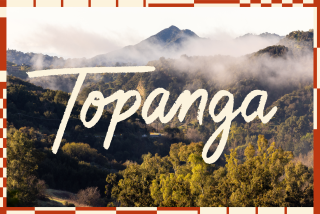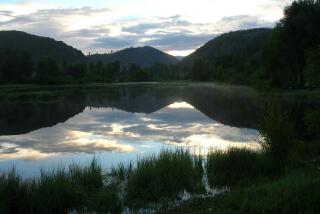THE BACK OF BEYOND : Time has a different quality in Australia’s tropical north, and Cooktown, site of the first European settlement, is no exception. : Getting to Cooktown is a hit-or-miss proposition when the monsoons are around.
COOKTOWN, Australia — The scruffy dog jumped off first, followed by its equally unkempt owner, seven aborigines, a Danish tourist, a plump woman from New Caledonia, a numerologist and, lastly, me.
After nearly eight hours cramped inside the battered mini-van that serves as the thrice-weekly Cairns-to-Cooktown bus, we had finally arrived.
A hand-painted hotel sign, worded in typically blunt Queensland fashion, said it all: “You’re bloody well here. Now you’ve got 172 miles to get back.”
It did seem as if we had reached the back of beyond. Cooktown, a small settlement of roughly 1,000 at the mouth of the Endeavour River, is about as far north as one can travel by road during the Wet, as Australians at the top of their continent call the rainy season.
Getting to Cooktown is a hit-or-miss proposition when the monsoons are around. For almost half its length, the road from Cairns is little more than a dirt track, deeply rutted and sometimes washed away.
It had been raining in Cairns when we left and I had wondered, rather hopefully, whether we might get stuck along the way.
“No worries, mate,” the driver said. “It’s my birthday. No way I’d miss the party. We’ll make it.”
It wasn’t until we were several miles into the journey that I realized that “no worries” seemed to be the theme for the trip. To begin with, the speedometer did not work.
“Never needed that thing anyway,” the driver said.
Then, too, the rear-view mirror on the passenger side was little more than a few shards of broken glass.
“Hit by a rock last time up,” he said. “No worries.”
The dog, exuding a curious aroma brought on by wet fur and an undoubtedly bizarre diet, spent the trip alternately wandering the narrow aisle, sniffing at all the passengers in turn, or curled up near one of the few open windows, thereby allowing the wind to provide us a full measure of his special fragrance.
Then there was the radio. The custom, it appeared, was to play it at almost full volume, effectively preventing the driver from hearing any complaints about the noise. Or for that matter, about the mongrel and his peculiar odor.
Several kilometers outside Cairns the road offers two choices. One option is to take Captain Cook Highway that hugs the Coral Sea coast on its way north to Port Douglas, the Daintree River country, and Cape Tribulation National Park. It is the more dramatic of the routes in terms of scenery, but even in the Dry only four-wheel-drive vehicles have any guarantee of making it through.
The other way, the way we went, is significantly longer, but not without its interesting points. The road traces a half-moon curve through the mountains and across the dry interior, eventually returning to the coast at Cooktown.
It was raining intermittently as we climbed into the foothills of the Great Dividing Range, the imposing backbone of mountains anchoring the east coast. Despite the weather, spirits were high. For some, like the aborigines, this was a journey home; for me it was a chance to add another piece to the jigsaw puzzle of impressions I was forming about Australia.
The higher we rose, the denser and more luxuriant the tropical rain forest became. Ferns and palms, tumbling waterfalls, interlaced canopies of vine and creeper, all vied for attention. Amid the myriad shades of green an occasional brilliantly colored flower or butterfly stood out in fine detail.
The air was heavy with the aroma of damp earth and leaves.
Before long we had passed through Kuranda, and from there the countryside opened and the sun became warmer as we left the shadow of the rain clouds.
Kennedy Highway heads south and west during this stretch until it meets the Peninsula Developmental Road, Cape York Peninsula’s main artery, at the farming center of Mareeba, where coffee and tobacco and cattle are the growing concerns.
The road turned north there and began crossing a series of dry creek beds and equally waterless rivers. It grew increasingly hot, and the lush vegetation we saw earlier was replaced by a more austere landscape.
Thirsty-looking gum trees and scrub land, through which cattle wandered in their haphazard manner, were now the common sights. Several times we were forced to slow or to brake sharply when we surprised these free-range animals lumbering across the road or simply standing in it.
Long, Arid Stretch
Mount Molloy, formerly a copper mining center, came and went, as did Mount Carbine, where wolfram is still taken from the earth in large quantities. A long, arid stretch ended with a climb that took us to Bob’s Lookout.
“Been about seven years since we’ve had a really good rain here,” the driver said.
Nor were the immediate prospects for a downpour any better. The loud music that we had been doing our best to ignore was interrupted for a news program that included a weather forecast.
“The monsoon trough over Papua New Guinea shows no sign of moving south,” the announcer said. Translation: There would be no appreciable rain in the near future.
The mention of Papua New Guinea, or PNG as it is called in Queensland’s far north, reminded me once again of Cooktown’s remoteness. The town is far closer to Port Moresby, PNG, for instance, than it is to Brisbane, Australia.
This train of thought was suddenly broken when we ran out of road. That is to say, the paved two-lane highway we had enjoyed ended abruptly. For the next four or five hours, with minor exceptions near towns and river crossings, we would be traveling on a narrow dirt road.
Soon dust became an issue. A strange cross between an armored car and a troop carrier hurtled past in the opposite direction, churning up clouds of dust and causing windows to be slammed shut.
I just had time to make out the words Cape York Expedition on its side before this vision from a Mad Max movie was gone, fleeing south before any monsoon made the rivers to the north impassable even for it.
By mid-afternoon we reached the Palmer River, where the discovery of gold in the 1870s brought prospectors by the thousands.
Today all that stands at Palmer River is the curious structure built by Louie Komsik and his wife Luba. Known as a roadhouse, it is part private home, part restaurant, part bar and part museum. It is also about all there is in the 144-kilometer stretch between Mount Carbine and Lakeland.
Komsik, who came to Australia from Eastern Europe in the early 1960s, is something of a local legend. On a wall near the front entrance he proudly displays a news clipping from the Brisbane Courier. The story says Louie was responsible for killing 40,000 crocodiles before legislation was enacted in 1972 making such hunting illegal.
Not Quite 40,000
Forty thousand? In little more than a decade? Well, no. Komsik is not one to deceive and he has corrected the Brisbane reporter’s error by crossing out the 40,000 and penciling in 14,000 in its place. The latter figure, he says, is accurate.
Some of Louie’s victims are in the roadhouse museum (a room off the bar). Walls and tables are adorned with crocodile skulls and skins, giant fish such as barramundi and grouper, old mining equipment, vintage rifles and various other bits and pieces from the gold rush days. All of it is material Komsik has caught or collected.
Back on the dirt road after a half-hour stop we soon found ourselves in a dust storm created by a large vehicle ahead. What it was we could not make out through the swirling yellow-white cloud it trailed, but our driver seemed intent on overtaking it at any cost.
What few windows remained open were quickly shut in a futile effort to keep out the dust. The temperature inside the bus rose, too, but the driver was undeterred.
“This road’s a bastard before the rains,” he said, accelerating despite the lack of visibility.
We were once again in the mountains, only this time there was no rain forest, only bare slopes and a discomfortingly sheer drop to the rocks below.
At a bend we saw the cause of all the dust, a road train carrying cattle. The unfortunate beasts looked like something from a nightmare, appearing and disappearing in the dust as we drew closer. Caked with dried mud, their horns tipped and blunted, their eyes protruding, they stared at us over the sides of the huge truck.
What their fate was to be, I did not know. What mine might be became horribly clear as the driver chose that moment to try to overtake the truck.
The rest of the passengers were preoccupied with cattle watching but I was more concerned with steer of another kind, and hoped that the driver was aware that calamity was just a turn of the wheel away.
He must have sensed my unease because once we had safely passed the huge truck he turned his head and grinned. “No worries,” he said.
But no one else seemed to have noticed how close to the crumbling edge we had come. The numerologist, for example, had not so much as raised his head from his paperback, “The Numbers of Life: The Hidden Powers of Numerology.”
Maybe he knew that his number was not yet up.
With the truck no longer blocking our way and the dust no longer obscuring our vision, we made better time.
Quartet of Kangaroos
Suddenly the bus braked sharply. Through the front window I saw four kangaroos hop in four directions not a moment too soon. The Australian back country always seems to have a surprise in store for the unwary.
At Black Mountain National Park the road, which had been heading east, turned north for the final run in to Cooktown.
The mountains, more like oversize hills, get their name from the large black boulders that cover them. It is a dark, eerie place even in the daytime, honeycombed with bat-infested caves and the subject of more than a few aboriginal legends.
Kalcajagga (Mountains of Death) is what the aborigines call the area, and local history is replete with tales of men who have disappeared among these sinister hills over the years. We didn’t linger and soon were pulling into Cooktown. The journey was over.
“Thanks, mate,” I said to the driver, “and happy birthday.”
“No worries,” he said, and off he went.
More to Read
Sign up for The Wild
We’ll help you find the best places to hike, bike and run, as well as the perfect silent spots for meditation and yoga.
You may occasionally receive promotional content from the Los Angeles Times.






